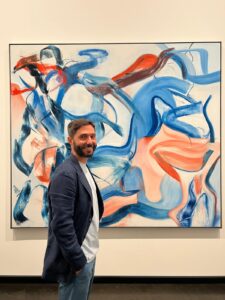You have a background in architecture and in art and cultural heritage management. How do these disciplines integrate and influence your daily work as an art consultant?
I’m very fortunate to have a foundation in artistic education: an experimental journey with solid grounding in Art History and artistic techniques that support my work every day. I approach every expressive phenomenon with a down-to-earth perspective, starting from the gesture to reach the meaning. I firmly believe that a great artist is someone who can materialize their thoughts, anticipating the possibility of letting them evolve in contact with the medium. Conceptual inconsistency and over-refinement deeply bore me.
How do you approach the creative process of setting up exhibitions for contemporary art?
I look to the past with admiration for that type of architecture so elevated that it steps aside to highlight the artworks. Museums often speak a lot about those who built them, but examples like Carlo Scarpa and Tadao Ando have shown us that to achieve the goal of enhancing art, architecture must know how to “disappear” with mastery.
What themes do you consider essential in your professional journey? Is there a particular piece of advice you tend to give to those trying to enter the world of contemporary art?
A fundamental theme for me, from which all others stem, is the “social role of contemporary art.” However, the ability to convey a vision of real change, heralding it with courage through the artworks, today represents a challenging task for two reasons.
The first is a dehumanized market that does not think in terms of ethics or socio-ecological sustainability. The second is the constant deviation of contemporary art toward a commercialism for bored rich people… frivolous and disengaged art at a time when the planet is burning, social inequalities are at historic highs, and wars are annihilating entire populations.
In this beautiful and troubled contemporary moment, there is fortunately still plenty of space for artistic storytelling. My advice for “breaking into this fantastic world” is simple but challenging: if no one understands you, find a way to express yourself through your time.
What trends do you observe in contemporary art? Is there any future development or emerging area that excites you or that you foresee will become more influential in the near future?
The disappearance of the human dimension from the center of works. Recently, there has been a trend towards an excessively colorful/decorative scenario, self-defining within mainstream research fields that “don’t step on anyone’s toes.” This results in a lack of analysis of today’s depths, and consequently, a diminishing of the branch of social criticism that contemporary art has always had (think of Pino Pascali and Emilio Vedova at the ’68 Biennale).
However, I have high hopes for contemporary painting, which, in recent years, has reached very high levels of research and seems ready to make the so-called “political leap.”
How do you define “success” for an artist in the context of contemporary art? Is there a balance between critical recognition, popularity, and artistic integrity that you consider ideal?
I don’t believe in the concept of success à la Andy Warhol, but I do believe in the recognizability of artistic research. The more effective the transmission of the message, the more popular it becomes, and the more immediate the feedback from the general public.
As for critical recognition, we know it’s a long and complex chapter that should never discourage those who are starting out… and those who persist! True art never takes too long to arrive.


